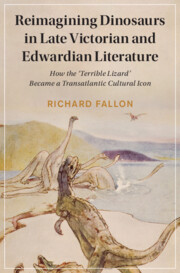 Reimagining Dinosaurs in Late Victorian and Edwardian Literature
Reimagining Dinosaurs in Late Victorian and Edwardian Literature Published online by Cambridge University Press: 28 October 2021
Chapter 2 explores a range of fictional and non-fictional writing on dinosaurs. The first half shows how different writers, including Henry Neville Hutchinson, Grant Allen, and geoscientist Henry Woodward, invoked the comic monsters of Lewis Carroll to develop a new, ‘grotesque’ register for describing dinosaurs. This language naturalised an emergent understanding of dinosaurs, especially American dinosaurs like Triceratops, as having gone extinct owing to the evolution of uselessly monstrous characteristics. These ideas were appealingly absurd to general audiences, who could contrast the progressive traits and intelligence of mammals like themselves with the doomed grotesqueness of the dinosaurs. The chapter’s second half examines this new way of talking about dinosaurs, providing close readings of humourist Eugene Field’s poem ‘Extinct Monsters’ (1893), Edward Cuming’s Wonders in Monsterland (1901), and Emily Bray’s Old Time and the Boy (1921). In addition to depicting dinosaurs through Carrollian nonsense conventions, all three of these texts were direct responses to the works of Hutchinson, demonstrating his long-term importance for the popularisation of dinosaurs.
To save this book to your Kindle, first ensure [email protected] is added to your Approved Personal Document E-mail List under your Personal Document Settings on the Manage Your Content and Devices page of your Amazon account. Then enter the ‘name’ part of your Kindle email address below. Find out more about saving to your Kindle.
Note you can select to save to either the @free.kindle.com or @kindle.com variations. ‘@free.kindle.com’ emails are free but can only be saved to your device when it is connected to wi-fi. ‘@kindle.com’ emails can be delivered even when you are not connected to wi-fi, but note that service fees apply.
Find out more about the Kindle Personal Document Service.
To save content items to your account, please confirm that you agree to abide by our usage policies. If this is the first time you use this feature, you will be asked to authorise Cambridge Core to connect with your account. Find out more about saving content to Dropbox.
To save content items to your account, please confirm that you agree to abide by our usage policies. If this is the first time you use this feature, you will be asked to authorise Cambridge Core to connect with your account. Find out more about saving content to Google Drive.